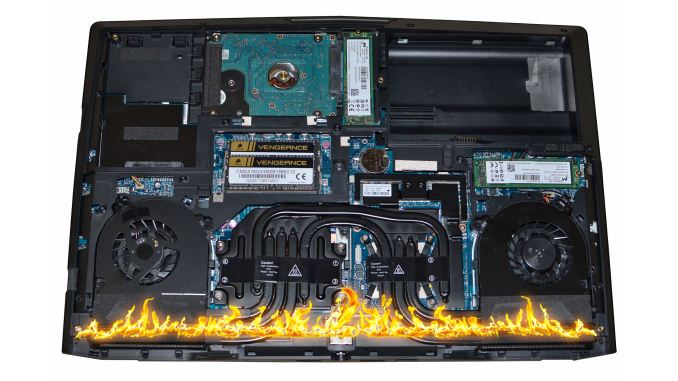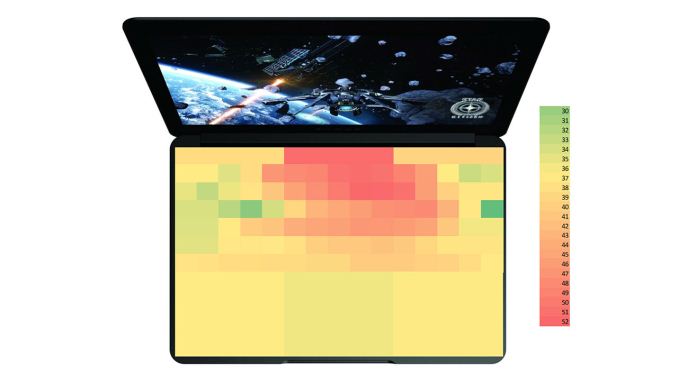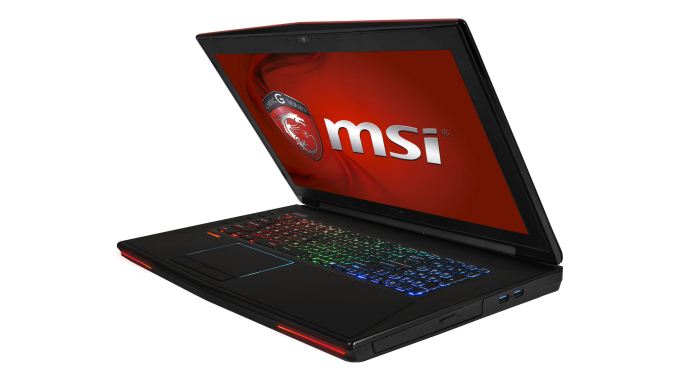NVIDIA Mobile Overclocking - There and Back Again
by Jarred Walton on February 20, 2015 2:25 PM EST- Posted in
- Laptops
- Gaming
- NVIDIA
- Overclocking
- Notebooks

The past few months have been a bit interesting on the mobile side of the fence for NVIDIA. Starting with the R346 drivers (347.09 beta and later), NVIDIA apparently decided to lock down overclocking of their mobile GPUs. While this is basically a non-issue for the vast majority of users, for the vocal minority of enthusiasts the reaction has been understandably harsh. Accusations have ranged from “bait and switch” (e.g. selling a laptop GPU that could be overclocked and then removing that “feature”) to “this is what happens when there’s no competition”, and everything in between.
NVIDIA for their part has had a few questionable posts as well, at one point stating that overclocking was just “a bug introduced into our drivers” – a bug that has apparently been around for how many years now? And with a 135MHz overclocking limit no less…. But there’s light at the end of the tunnel, as NVIDIA has now posted that they will be re-enabling overclocking with their next driver update, due in March. So that’s the brief history, but let’s talk about a few other aspects of what all of this means.
First and foremost, anyone that claims enabling/disabling overclocking of mobile GPUs is going to have a huge impact on NVIDIA’s bottom line is, in my view, spouting hyperbole and trying to create a lot of drama. I understand there are people that want this feature, and that’s fine, but for every person that looks at overclocking a mobile GPU there are going to be 100 more (1000 more?) that never give overclocking a first thought, let alone a second one. And for many of those people, disabling overclocking entirely isn't really a bad idea – a way to protect the user from themselves, basically. I also don’t think that removing overclocking was ever done due to the lack of competition, though it might have had a small role to play. At most, I think NVIDIA might have disabled overclocking because it’s a way to keep people from effectively turning a GTX 780M into a GTX 880M, or the current GTX 980M into a… GTX 1080M (or whatever they call the next version).
NVIDIA’s story carries plenty of weight with me, as I’ve been reviewing and helping people with laptops for over a decade. Their initial comment was, “Overclocking is by no means a trivial feature, and depends on thoughtful design of thermal, electrical, and other considerations. By overclocking a notebook, a user risks serious damage to the system that could result in non-functional systems, reduced notebook life, or many other effects.” This is absolutely true, and I’ve seen plenty of laptops where the GPU has failed after 2-3 years of use, and that’s without overclocking. I've also seen a few GTX 780M notebooks where running at stock speeds isn't 100% stable, especially for prolonged periods of time. Sometimes it’s possible to fix the problem; many people simply end up buying a new laptop and moving on, disgruntled at the OEM for building a shoddy notebook.
For users taking something like a Razer Blade and trying to overclock the GPU, I also think pushing the limits of the hardware beyond what the OEM certified is just asking for trouble. Gaming GPUs and “thin and light” are generally at opposite ends of the laptop spectrum, and in our experience the laptops can already get pretty toasty while gaming. So if you have a laptop that is already nearing the throttling point, overclocking the GPU is going to increase the potential of throttling or potentially even damage the hardware. Again, I’ve seen enough failed laptops that there’s definitely an element of risk – many laptops seem to struggle to run reliably for more than 2-3 years under frequent gaming workloads, so increasing the cooling demands is just going to exacerbate the problem.
On the other hand, if you have a large gaming notebook with a lot of cooling potential and the system generally doesn't get hot, sure, it’s nice to be able to push the hardware a bit further if you want. Built-in throttling features should also protect the hardware from any immediate damage. We don’t normally investigate overclocking potential on notebooks as it can vary even between units of the same model, and in many cases it voids the warranty, but enthusiasts are a breed apart. My personal opinion is that for a gaming laptop, you should try to keep GPU temperatures under 85C to be safe (which is what most OEMs tend to target); when laptops exceed that “safe zone” (with or without overclocking), I worry about the long-term reliability prospects. If you have a GPU that’s running at 70C under load, however, you can probably reliably run the clocks at the maximum +135MHz that NVIDIA allows.
We’re currently in the process of testing a couple of gaming notebooks, and given the timing of this we’re going to use this as an opportunity to try some overclocking – with the older 344.75 drivers for now. We’ll have a separate article digging into the overclocking results later, but again I’d urge users to err on the side of caution rather than trying to redline your mobile GPU. What that means in practice is that mobile GPU overclocking is mostly going to be of use for people with larger gaming notebooks – generally the high-end Alienware, ASUS, Clevo, and MSI models. There may be other laptops where you can squeeze out some extra performance (e.g. some models with GTX 850M/860M, or maybe even some older GT 750M laptops), but keep an eye on the thermals if you want to go that route.












36 Comments
View All Comments
daerragh - Sunday, February 22, 2015 - link
You might overclock nVidia GPUs above the 135 MHz limit with nVidia Inspector. At least that's what I'm doing with my GTX660M. In nVidia Inspector you just force the 2nd perfomance mode P5 (not the highest mode which is P0). The P5 step can be overclocked as high as the GPU allows. I'm OCing 660M from 835 MHz core to 1300 MHz and the memory from 2500 MHz to 1300 MHz. The laptop is Lenovo Y580. With this overclock I manage to score 2400 point in 3DMark FireStrike which is the best score for any GTX 660M in 3DMarks database. Here's the link: http://www.3dmark.com/fs/4124687daerragh - Sunday, February 22, 2015 - link
You force the P5 state by making a shortcut to the nVidia Inspector .exe file with this parameter: "C:\nvidiaInspector.exe -forcepstate:0,5". To go back to the default state you make a shortcut with this parameter: "C:\nvidiaInspector.exe -forcePState:0,16". You can choose which state to overclock in nVidia Inspector's GUI. You might find a broader description about how to do it on the net somewhere.Atakelane - Sunday, February 22, 2015 - link
First of all, I think that Nvidia saying a "bug" allowed their mobile GPU's to be OC'ed is an eyewash. Secondly, the last time they put forward such "innocent lies" was the time of the 970 fiasco. I think they are again trying to hide some flaw in their Maxwell mobile GPU's by disabling the OC.It is strange that the author blindly supports Nvidia in the issue. I mean that any OC'ing is risky if one is not entirely technically sound about it and by that logic, Nvidia can disable OC'ing in their desktop cards also. The same thermal and visual issues apply to the desktop cards also while OC'ing. Then why just the mobile cards? Also, I have OC'ed fermi and Kepler cards even with the new driver and that means Nvidia has disabled them for Maxwell gen only. Why?????
Michael Bay - Thursday, February 26, 2015 - link
The "flaw" in 970 manifests itself in the loss of staggering 1% to 3% of performance in 4Gb VRAM scenarios. Measurement deviation, in other words.So Jarred is completely justified in his unwillingness to confirm whatever delusions tinfoil hats may have.
watermark0n - Monday, February 23, 2015 - link
I usually use the overclocking feature to underclock my card. If it were removed, I simply wouldn't be able to play most games, as the manufacturer of this laptop did not properly thermally insulate the laptop. Disabling clock adjustments even in third party tools was especially a douche move.bennyg - Friday, February 27, 2015 - link
Totally agree. I try and keep heat down by underclocking and using lower graphic settings and vsync in games where I can't see the difference from higher settings. Or overclock as the GTX680M is starting to need it in some situations (and it easily does +135MHz core). I do utterly flog my gaming laptops, they spend probably 10 hours on average per day on as it doubles as my work machine. I've had a G51J which would get past 95C on stock clocks which I had to play around with a bunch of temperature based clock profiles to keep it in the low 90's, which is still working as a HTPC to this day nearly 6 years on (and needs another repaste as it idles in the 70s and the 60% underclock it runs gets high 80's) but has had a relatively easier life since I backed over it and wrecked the screen.Which brings me to another point, just like cars, if I had to choose a 20yr old car I would much rather one with moderately high milage and a preventative service record than a 20yr old garage queen that's got a low milage and is still on original everything. As an 'enthusiast' I know how to look after my stuff and know the importance of cleaning, blowing out fan grilles and repasting heatsinks. As hard as it is to do those on most laptops by the OEMs that complained and got Nvidia to try this harebrained lockout in the first place ("bug" trololol) - this is one of the many reasons I've had Clevos for four years now and they fit my purposes perfectly.
And even though it's 17 inch and 3kg+ I can carry it in a backpack easily, and most importantly, sit on the couch. Or in the kitchen while cooking. Or outside. Which you can't do with your desktop as it's stuck on your desk. So can this stupid internet statement that gaming laptops are a stupid product just be ended forever. If you don't want one don't buy one. Kthx